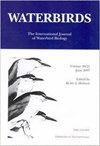繁殖期和非繁殖期黑孔鹱的同位素模式变异
IF 0.6
4区 生物学
Q3 ORNITHOLOGY
引用次数: 1
摘要
摘要在繁殖周期的各个阶段,海鸟根据自身的生理需要和环境条件,采用不同的觅食策略。在繁殖季节,海鸟采取中心觅食策略,而在繁殖季节之后,在蜕皮期间,它们会迁移到遥远的非繁殖地,在那里停留几个月。直到最近,人们对它们在迁徙过程中的分布和生态知之甚少。通过分析羽毛中碳(δ13C)和氮(δ15N)的同位素比值,可以填补这一关于大规模运动和生态的知识空白。分析稳定的同位素比率可以深入了解物种的觅食生态和蜕皮期的变化。我们首先确定了黑孔鹱(Puffinus opisthomelas)的换羽策略。然后,我们通过分析羽毛中的稳定同位素推断出它们的非繁殖期分布范围和营养生态位的变化。观测到的δ13C值表明,这些鸟类都迁移到相似的终端非繁殖区。冬季至繁殖期,不同性别间的δ15N值基本一致;然而,在繁殖后期,它们的水平是不同的。两性在繁殖后利用的营养水平略有不同,使用沿海和远洋水域的方式不同,这可能会减少它们在繁殖后蜕皮期间的竞争。本文章由计算机程序翻译,如有差异,请以英文原文为准。
The Isotopic Pattern Variability in the Breeding and Non-Breeding Black-Vented Shearwater
Abstract. Seabirds utilize different foraging strategies based on their physical needs and environmental conditions during the stages of their reproductive cycle. During their breeding season, seabirds assume a central-place foraging strategy, while after the reproductive season, during their molt, they migrate to distant non-breeding grounds where they remain for several months. Until recently, little was known about their distribution and ecology during migration. This gap in knowledge regarding large-scale movements and ecology could be filled by analyzing isotopic ratios of carbon (δ13C) and nitrogen (δ15N) in the feathers. Analyzing stable isotope ratios provides insights into the species' foraging ecology and variations along the molting period. We first ascertained the molting strategy of the Black-vented Shearwaters (Puffinus opisthomelas). We then inferred their non-breeding period distribution range and variations in the trophic niche by analysing stable isotopes in feathers. The observed δ13C values reveal that these birds all migrate to similar terminal non-breeding areas. Values of δ15N were similar between sexes during winter and up to the reproductive period; however, their levels were distinct during the post-breeding period. Sexes exploited slightly different trophic levels during the post-breeding period, differently using coastal and pelagic waters, likely to reduce competition during their post-breeding molt.
求助全文
通过发布文献求助,成功后即可免费获取论文全文。
去求助
来源期刊

Waterbirds
生物-鸟类学
CiteScore
1.30
自引率
0.00%
发文量
0
审稿时长
6-12 weeks
期刊介绍:
Waterbirds is an international scientific journal of the Waterbird Society. The journal is published four times a year (March, June, September and December) and specializes in the biology, abundance, ecology, management and conservation of all waterbird species living in marine, estuarine and freshwater habitats. Waterbirds welcomes submission of scientific articles and notes containing the results of original studies worldwide, unsolicited critical commentary and reviews of appropriate topics.
 求助内容:
求助内容: 应助结果提醒方式:
应助结果提醒方式:


